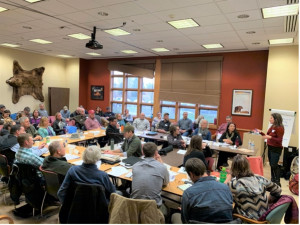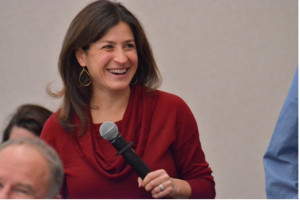By Heather Stokes

I have always been interested in what motivates people. What connects us, what divides us, and why? Increasingly, I feel we are more invested in our divisions than our common ground. But a recent experience reminded me that common ground still exists.
The debate in Montana over grizzly bears has exemplified division. Some people hate grizzlies for their impacts on livestock and livelihoods. Some people love grizzlies for their majesty and connection to nature. In 2019, Governor Bullock created the Grizzly Bear Advisory Council to develop realistic, sustainable recommendations for grizzly bear conservation and management. Many doubted this Council, made up of 18 incredibly diverse Montanans, could find common ground.
I was chosen to co-facilitate this Council to help them find that elusive common ground by applying my diverse skills to a process that involved complex federal-state-tribal wildlife management issues. Tensions were high between the public, interest groups and agencies. Throughout this process, my own core values of integrity, honesty and respect were tested.
Get notified when new articles are posted to the EDR blog – sign up for our email list »
Thirty years ago, we used biology to guide species protection, often separating people from nature. Today we know natural resource management requires an understanding of human behavior, including how to create and sustain diverse interpersonal relationships and strategic collaborative partnerships. To address the tensions between a growing human population and our shrinking natural resources, we must understand the values, cultures and livelihoods that form the foundation of our attitudes, beliefs, and behaviors. Without such an understanding, it is easy to feel threatened and difficult to be heard.
We wish to be heard in a way that reflects understanding. The better we listen, the more others will feel understood. The better we communicate, the more likely we are to feel understood. Understanding creates empathy, connection, trust, and safety. While we are most comfortable with like-minded people, the more interdisciplinary and inclusive our approach, the more likely we are to find strong common ground.
When the Council began its work, each member stated a sincere interest to work together, yet they acknowledged doubt about how actually to do so. Under intense pressure and public scrutiny, they had to navigate through tenuous discussions to create realistic, achievable, consensus-based recommendations for grizzly bear conservation and management in Montana.
In the beginning, each member had been labeled private landowner, conservationist, hunter, recreationist, farmer, outfitter, educator, etc. However, they soon realized that with such labels they were not being understood in their broader context. For example, the conservationist was also a hunter and recreationist. The private landowner was a committed conservationist. They were more multi-dimensional than one label or position. When they began to identify with rich, varied experiences of their full lives rather than a label or title, they began to establish common ground.
After four months of building shared knowledge and developing relationships, Council members established enough trust to engage in difficult deliberations. In one challenging meeting, many of them came to the defense of other members who felt attacked by the public. They began to collectively embrace the many identities and experiences they brought to the table.
It has been six months since the Council presented their recommendations to Governor Bullock. Most, but not all recommendations reached consensus. A consensus on grizzly bear hunting eluded the Council, but even there they reached consensus on how to frame future hunting discussions. This was a strong accomplishment.
The Council succeeded because members showed up with positive intention, perseverance, and vulnerability. Through vulnerability, common ground surfaced amongst the members. They indicated a love for Montana – their home. They shared their experiences as stewards for the land and their communities. Some members were recent arrivals to the state. Others were from multi-generational Montana families. They are all impacted by bear management decisions.
As a facilitator, I have sometimes been criticized for not moving the process along faster . . . for allowing so much time for ‘wordsmithing.’ Sitting with process can feel like a waste of time when deliverables are looming. Yet sitting in the chaos, with purpose and direction, allows for difficult discussions and true understanding of others’ perspectives. By helping groups acknowledge what is, I am creating space for what can be.
Convening advisory groups has great potential to bring people together to resolve tenuous community issues. It must be done thoughtfully, sincerely, and patiently. I am committed to seeing the strengths in each individual and helping build bridges that allow for sustainable, collaborative partnerships. When there is broader understanding of what is at stake and the realization that the end goal is similar for all at the table, there is greater ability to give a little to get a lot. It does not mean compromising one’s values . . . it is giving a little for the greater good – and that good can include oneself.

Heather Stokes is a Senior Facilitator at the Center for Natural Resources and Environmental Policy at the University of Montana. She is passionate about empowering people and organizations to purposefully and strategically collaborate for the betterment of our communities, landscapes, and environment.
